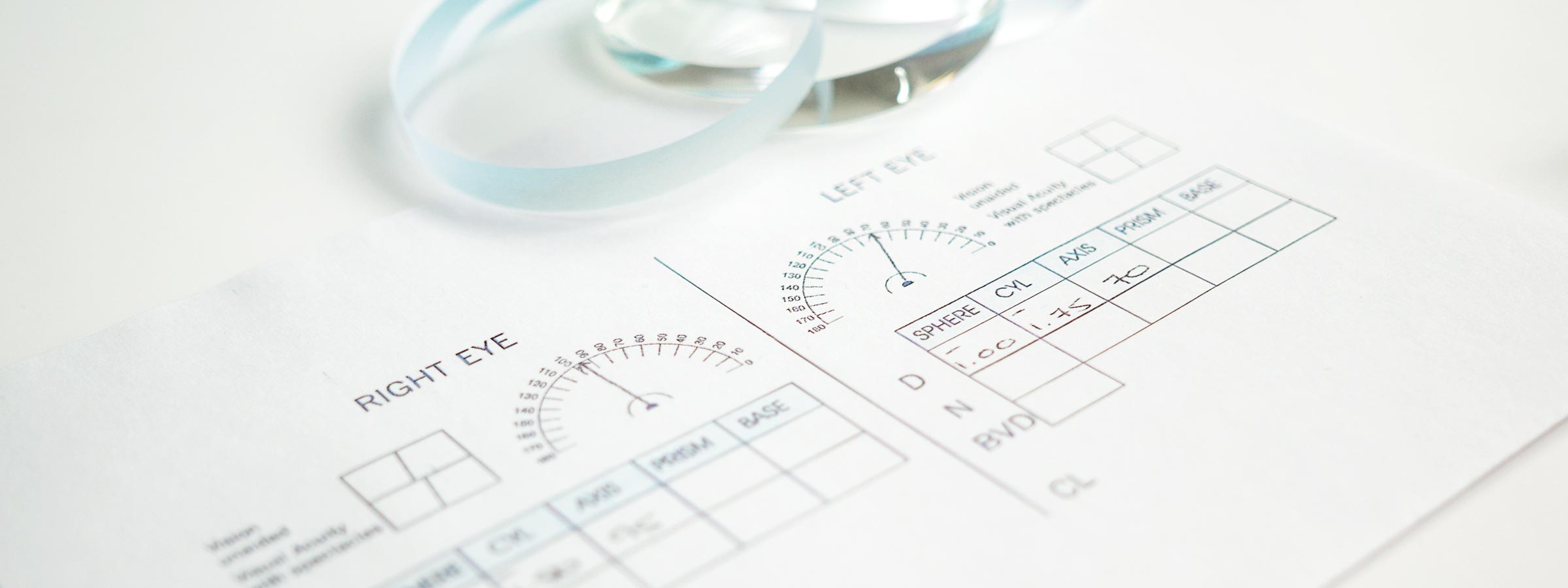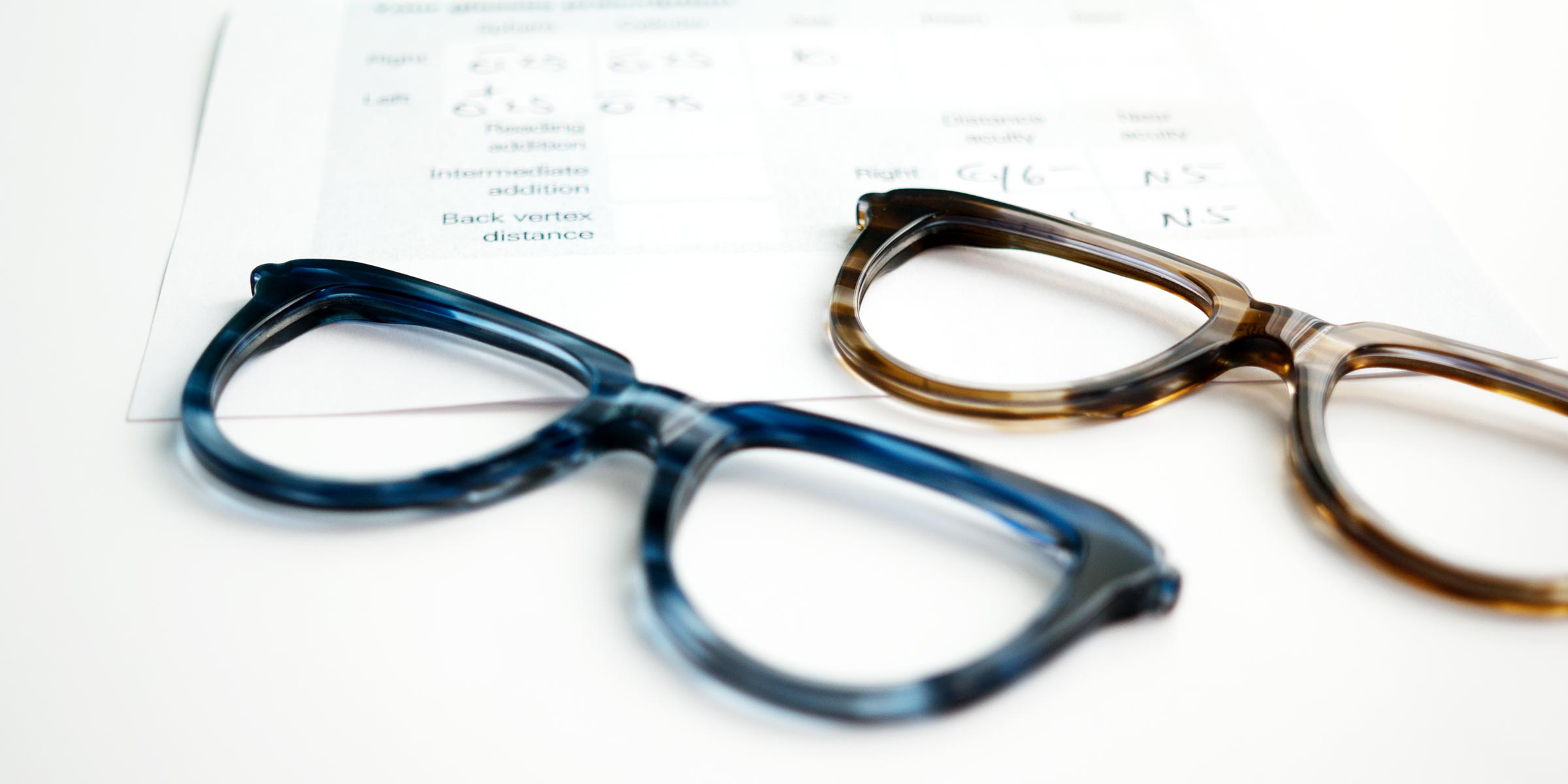Search based on the size of your current glasses
- Shop by shape
- Shop by colour
- Shop by size


You’ve just had your eyes tested and the optician has handed you a slip of paper with different symbols, letters and numbers written on it. This is your prescription and an up-to-date one is needed to buy a new pair of glasses online or in-store.
But what does all this mean and why is it so important?
In this article, we’ll explain why you need a prescription, why they’re important and what all the numbers and symbols mean.
A prescription is an important written document given by a qualified optometrist or suitably qualified medical practitioner, outlining a specific treatment. In the case of eyes, a prescription is given out by an optometrist or ophthalmologist and shows the health of the eye and recommends the strength of the lens you need to see clearly. It’s important to note that by law you should always receive a copy of your prescription. If you are not given one after your eye test, you should ask for it.


Prescriptions are important because they help determine the strength of your lenses, which lenses will work best for your eyes and, to some extent, what frames you can wear. For example, a very high short-sighted prescription would not suit a semi-rimless or metal frame as the lens required could stick out significantly.
Prescriptions for glasses are different from those for contact lenses and vice versa. This is because contact lenses sit directly on the eyeball, whereas glasses rest about one centimetre away from your eyes. A contact lenses prescription will include extra information such as base curve, diameter, lens brand or material, and expiration date. Additionally, whereas you can go about two years between glasses prescriptions, you need a new contact lens prescription at least every year.
In the same way that prescriptions for glasses and contact lenses are different, so are prescriptions for single vision and multifocal prescriptions. Multifocal prescriptions are made up of two or more prescriptions (one for distance and one for reading), so you can expect your prescription to look different.


Ever wondered what all the symbols and numbers on your prescription mean? Below is what you might find on your prescription and what it symbolises.
The ‘+’ sign indicates long-sightedness and the ‘-‘ means short-sightedness.
This stands for ‘Pupillary Distance’ – it states the distance between your eyes measured from the centre point of your pupils. Typically, the optician will not add this to your prescription, so you should ask for it as those with high-strength prescriptions need to have lenses that are centred more accurately.
This is your ‘Spherical Number’. It shows how strong your vision correction needs to be.
Other symbols can also be found in this section, including the infinity symbol (which looks like a sideways eight) or the word Plano (or Pl). These are the equivalent of ‘zero’ and are used when no sight correction is required.
Another common term that can be found on prescriptions is V/A (or Visual Acuity) which measures the standard of vision when corrected.
This is an abbreviated way of writing in your ‘Cylinder Number’, and it shows how much astigmatism you have. Astigmatism is when the front part of your eye is shaped more like a rugby ball than a regular circle. The number written in this section can be negative or positive.
Axis shows the position of the cylinder and it will be a number between 1 and 180.
This shows if you have a muscle imbalance in your eye. It is uncommon to see this box filled in as it is a fairly rare occurrence. If you do have a Prism number written on your prescription, it is usually done so as a fraction (1½, for example).
This shows the direction of the prism in your lens. It is fairly uncommon for this to be noted in your prescription, but if it is, it’ll be written as IN, OUT, UP or DOWN.
Sometimes written as ‘NV’ or ‘Near Addition’, this will indicate if you need a prescription for reading and is applied to bifocal and varifocal lenses to correct presbyopia. You may also see ‘Inter Add’, which is for computers and other tasks, such as reading music on a stand.
Knowing these terms means it’ll be easier for you to talk about your prescription with our opticians when ordering your glasses online.
Before submitting your prescription to us, you must make sure it is up-to-date. Experts advise having your eyes tested at least once every two years, or more frequently depending on your age group and general optical health. You find out more about this, as well as find ways to save on your next eye test, on this page.
Is there anything else you’d like to know? You can find more information about how to read and submit your prescription here.